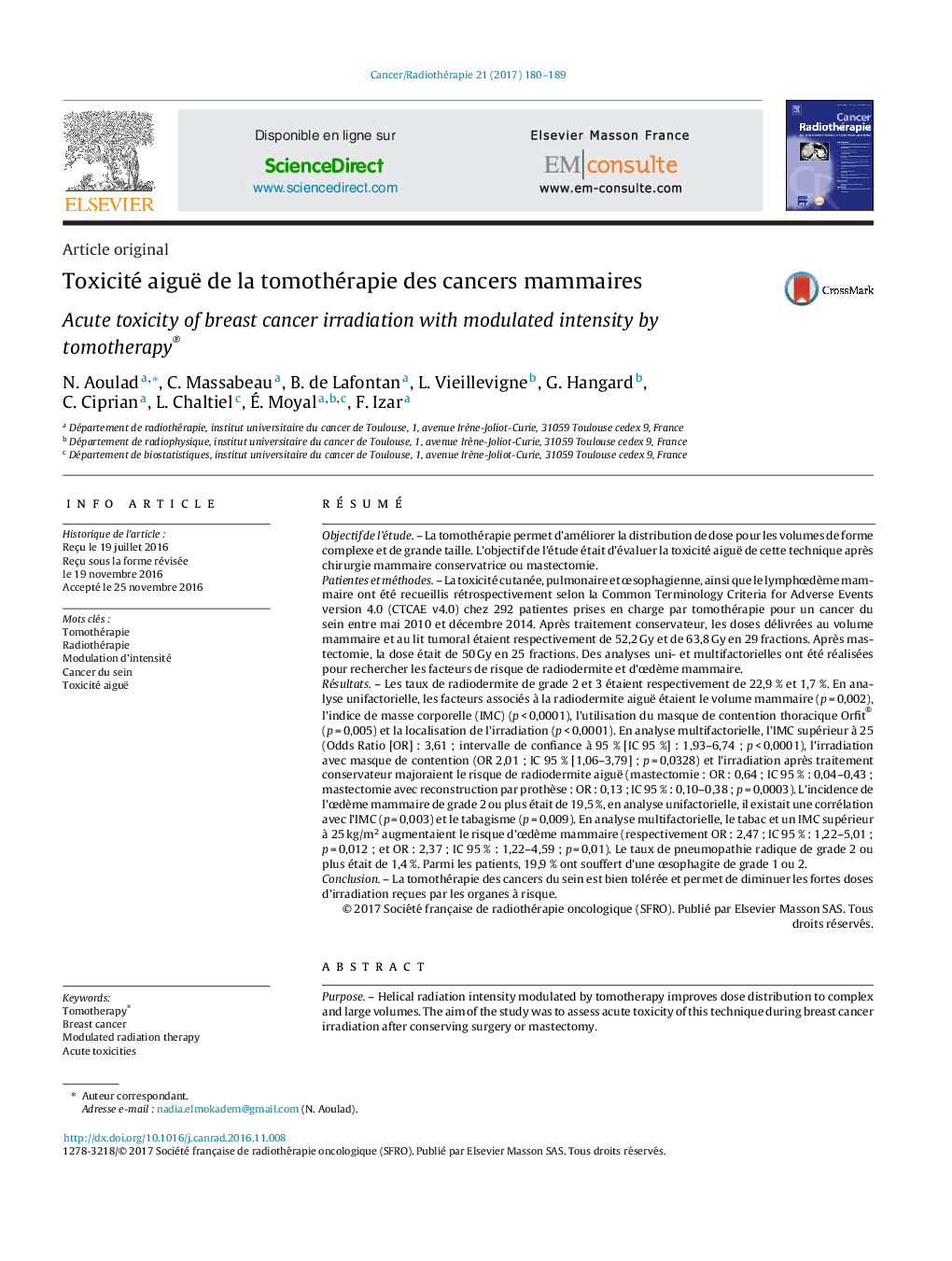| کد مقاله | کد نشریه | سال انتشار | مقاله انگلیسی | نسخه تمام متن |
|---|---|---|---|---|
| 5525876 | 1401503 | 2017 | 10 صفحه PDF | دانلود رایگان |

RésuméObjectif de l'étudeLa tomothérapie permet d'améliorer la distribution de dose pour les volumes de forme complexe et de grande taille. L'objectif de l'étude était d'évaluer la toxicité aiguë de cette technique après chirurgie mammaire conservatrice ou mastectomie.Patientes et méthodesLa toxicité cutanée, pulmonaire et Åsophagienne, ainsi que le lymphÅdème mammaire ont été recueillis rétrospectivement selon la Common Terminology Criteria for Adverse Events version 4.0 (CTCAE v4.0) chez 292 patientes prises en charge par tomothérapie pour un cancer du sein entre mai 2010 et décembre 2014. Après traitement conservateur, les doses délivrées au volume mammaire et au lit tumoral étaient respectivement de 52,2 Gy et de 63,8 Gy en 29 fractions. Après mastectomie, la dose était de 50 Gy en 25 fractions. Des analyses uni- et multifactorielles ont été réalisées pour rechercher les facteurs de risque de radiodermite et d'Ådème mammaire.RésultatsLes taux de radiodermite de grade 2 et 3 étaient respectivement de 22,9 % et 1,7 %. En analyse unifactorielle, les facteurs associés à la radiodermite aiguë étaient le volume mammaire (p = 0,002), l'indice de masse corporelle (IMC) (p < 0,0001), l'utilisation du masque de contention thoracique Orfit® (p = 0,005) et la localisation de l'irradiation (p < 0,0001). En analyse multifactorielle, l'IMC supérieur à 25 (Odds Ratio [OR] : 3,61 ; intervalle de confiance à 95 % [IC 95 %] : 1,93-6,74 ; p < 0,0001), l'irradiation avec masque de contention (OR 2,01 ; IC 95 % [1,06-3,79] ; p = 0,0328) et l'irradiation après traitement conservateur majoraient le risque de radiodermite aiguë (mastectomie : OR : 0,64 ; IC 95 % : 0,04-0,43 ; mastectomie avec reconstruction par prothèse : OR : 0,13 ; IC 95 % : 0,10-0,38 ; p = 0,0003). L'incidence de l'Ådème mammaire de grade 2 ou plus était de 19,5 %, en analyse unifactorielle, il existait une corrélation avec l'IMC (p = 0,003) et le tabagisme (p = 0,009). En analyse multifactorielle, le tabac et un IMC supérieur à 25 kg/m2 augmentaient le risque d'Ådème mammaire (respectivement OR : 2,47 ; IC 95 % : 1,22-5,01 ; p = 0,012 ; et OR : 2,37 ; IC 95 % : 1,22-4,59 ; p = 0,01). Le taux de pneumopathie radique de grade 2 ou plus était de 1,4 %. Parmi les patients, 19,9 % ont souffert d'une Åsophagite de grade 1 ou 2.ConclusionLa tomothérapie des cancers du sein est bien tolérée et permet de diminuer les fortes doses d'irradiation reçues par les organes à risque.
PurposeHelical radiation intensity modulated by tomotherapy improves dose distribution to complex and large volumes. The aim of the study was to assess acute toxicity of this technique during breast cancer irradiation after conserving surgery or mastectomy.Patients and methodsCutaneous toxicities, lung and oesophageal side effects, and breast lymphedema were retrospectively collected according to the Common Terminology Criteria for Adverse Events Version 4.0 (CTCAE v4.0) in 292 patients treated for a breast cancer by tomotherapy between May 2010 and December 2014. After conservative surgery, the dose administered to breast volume and the tumour bed was respectively 52.2Â Gy and 63.8Â Gy in 29 fractions. After mastectomy, the dose was 50Â Gy in 25 fractions. Univariate and multivariate analyses were performed to highlight risk factors for dermatitis and breast oedema.ResultsThe rate of dermatitis grade 2Â and 3Â were 22.9% and 1.7% respectively. In univariate analysis, factors associated with acute radiation dermatitis were breast volume (PÂ =Â 0.002), body mass index (BMI) (PÂ <Â 0.0001), the use of chest compression mask (net) (PÂ =Â 0.005) and the localization of the irradiation (P <0.0001). In multivariate analysis, BMI greater than 25Â kg/m2 (odds ratio [OR]: 3.61, 95% confidence interval [CI]: [1.93-6.74], PÂ <Â 0.0001), the use of a chest mask (OR 2.01, 95% CI [1.06-3.79] PÂ =Â 0.0328) and irradiation after conservative treatment increase the risk of acute radiation dermatitis (mastectomy: OR 0.64, 95% CI [0.04-0.43]; mastectomy with immediate reconstruction with prosthesis: OR 0.13 95% CI [0.10-0.38] PÂ =Â 0.0003). The incidence of breast oedema grade 2Â or above was 19.5%, in univariate analysis, there was a correlation with BMI (PÂ =Â 0.003) and smoking (PÂ =Â 0.009). In multivariate analysis, smoking and BMI greater than 25Â kg/m2Â increased the risk of breast oedema (OR 2.47, respectively [95% CI 1.22-5.01] PÂ =Â 0.012Â and OR 2.37 [95% CI 1.22-4.59] PÂ =Â 0.01). The rate of radiation pneumonitis of grade 2Â or above was 1.4%. Among the patients, 19.9% had esophagitis grade 1Â or 2.ConclusionThe helical irradiation intensity modulation tomotherapy is a well-tolerated treatment for breast cancer that reduces the high radiation doses to organs at risk.
Journal: Cancer/Radiothérapie - Volume 21, Issue 3, May 2017, Pages 180-189